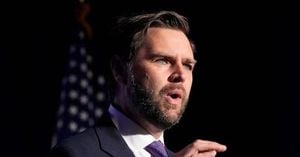In a week marked by sweeping changes across key federal agencies, the U.S. government has initiated two of the most significant workforce reductions in recent memory, affecting both the intelligence and public health sectors. The Office of the Director of National Intelligence (ODNI) announced a dramatic downsizing of its workforce and budget, while the Centers for Disease Control and Prevention (CDC) began issuing permanent termination notices to hundreds of employees. These moves, justified by officials as necessary for efficiency and accountability, have sparked fierce debate about the nation’s preparedness against threats both foreign and domestic.
On August 20, 2025, the ODNI revealed it would cut its workforce by more than 40% and reduce its annual budget by over $700 million. According to the Associated Press, the announcement came directly from Tulsi Gabbard, the director of national intelligence, who did not mince words in her assessment of the agency’s recent history. “Over the last 20 years, ODNI has become bloated and inefficient, and the intelligence community is rife with abuse of power, unauthorized leaks of classified intelligence, and politicized weaponization of intelligence,” Gabbard declared. She added, “Ending the weaponization of intelligence and holding bad actors accountable are essential to begin to earn the American people’s trust which has long been eroded.”
The ODNI, established in 2004 to coordinate the work of America’s 18 intelligence agencies, has played a central role in counterterrorism and counterintelligence operations. Its latest restructuring includes the downsizing of the Foreign Malign Influence Center, created in 2022 to track foreign interference in U.S. elections. The center’s core functions will be absorbed by other government agencies. Gabbard argued that the center had developed a “hyper-focus” on election-related work and accused it of being “used by the previous administration to justify the suppression of free speech and to censor political opposition.”
The Foreign Malign Influence Center was initially established by the Biden administration in response to assessments that Russia and other adversaries were attempting to sway American elections. Its mission was to coordinate intelligence on malign influence and alert the public to foreign disinformation campaigns, such as the widely circulated Russian video falsely showing mail-in ballots being destroyed in Pennsylvania before the 2024 presidential election. Despite its intended sunset at the end of 2028, Gabbard’s move effectively terminates the center now. Emerson Brooking of the Atlantic Council’s Digital Forensic Research Lab countered Gabbard’s justification, saying, “It wasn’t redundant, it was supposed to solve for redundancy.”
The ODNI cuts are part of a broader effort by the Trump administration to reshape how the federal government addresses foreign threats to U.S. democracy. Earlier this year, Attorney General Pam Bondi disbanded an FBI task force investigating foreign influence operations, while the State Department shuttered its office dedicated to countering misinformation from Russia, China, and Iran. The U.S. Cybersecurity and Infrastructure Security Agency, responsible for protecting critical infrastructure including election systems, has also faced significant budget reductions.
Reactions in Congress have fallen along familiar partisan lines. Senator Tom Cotton, Republican chairman of the Senate Intelligence Committee, praised the downsizing as “an important step towards returning ODNI to that original size, scope, and mission. And it will help make it a stronger and more effective national security tool for President Trump.” On the other hand, Senator Mark Warner, the panel’s top Democrat, expressed deep reservations, pledging to “conduct rigorous oversight to ensure any reforms strengthen, not weaken, our national security.” Warner added, “I am not confident that will be the case given Director Gabbard’s track record of politicizing intelligence.”
Meanwhile, the CDC is undergoing its own seismic shift. As of August 18, 2025, at least 600 CDC employees received permanent termination notices, following a court decision that protected some but not all workers from layoffs. The layoffs come as part of a restructuring and downsizing effort by the U.S. Department of Health and Human Services (HHS), which began notifying employees of possible job losses back on April 1, 2025. Many affected CDC staff had been on paid administrative leave since then, awaiting the outcome of ongoing lawsuits.
The American Federation of Government Employees (AFGE), which represents more than 2,000 CDC members, described a “staggering lack of transparency from HHS” regarding who was being let go. Among the 600 laid-off employees are about 100 who worked in violence prevention—a particularly painful blow coming less than two weeks after a tragic shooting on the CDC’s Atlanta campus, where a police officer lost his life. “The irony is devastating: The very experts trained to understand, interrupt and prevent this kind of violence were among those whose jobs were eliminated,” affected employees wrote in a recent blog post.
The layoffs have touched a broad swath of the CDC’s mission. While a federal judge in Rhode Island issued a preliminary ruling protecting employees in divisions dealing with smoking, reproductive health, environmental health, workplace safety, birth defects, and sexually transmitted diseases, other parts of the agency—including the freedom of information office and violence prevention projects—were not spared. Programs aimed at preventing rape, child abuse, and teen dating violence have been disrupted. Some of the laid-off staff had also played key roles in international efforts, helping other countries track violence against children and organizing a global conference on violence reduction.
Tom Simon, the retired senior director for scientific programs at the CDC’s Division of Violence Prevention, lamented the loss of expertise, saying, “There are nationally and internationally recognized experts that will be impossible to replace.”
Both the intelligence and public health shake-ups are part of a larger trend under the Trump administration to shrink the federal workforce and cut costs. Early in Trump’s tenure, Elon Musk and the Department of Government Efficiency oversaw mass layoffs across multiple agencies—a mandate that appears to be continuing with these latest decisions. The administration has justified the moves as necessary to improve efficiency and restore public trust, but critics argue the cuts risk undermining the very functions that protect Americans from complex and evolving threats.
For the intelligence community, the question remains whether consolidating and downsizing will truly make the nation safer or simply leave it less prepared to counter foreign interference and other dangers. For public health, the loss of hundreds of CDC professionals—many with specialized knowledge in violence prevention and international collaboration—raises concerns about the country’s ability to respond to both ongoing and emerging health crises.
As the dust settles, lawmakers and the public alike are left to grapple with the consequences of these sweeping changes. The coming months will reveal whether the promised gains in efficiency and accountability outweigh the risks posed by a leaner, less experienced government workforce.




